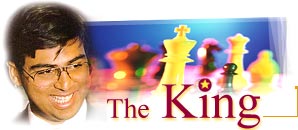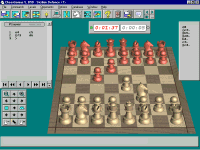
Part V -- Man versus Machine
Before moving to 1995 and the two championship -- FIDE, and PCA -- cycles that Anand participated in, in course of his first serious tilt at the world crown, an interesting development needs review.
From the late eighties on, the leading grandmasters had been harnessing the processing power and speed of the computer to augment their own skills. It was in 1994, however, that the computer moved out of the backroom, and took centre stage.
The first computer -- or more accurately, chess software -- to compete on equal terms with humans was Fritz, powered by the Intel Pentium. Intel needed to showcase the processing power of the Pentium, and having its state of the art microprocessor power a software capable of meeting, and beating, the world's best was just the right prescription.
Intel, thus, sponsored a speed-chess tournament in Munich, with the world's best participating alongside Fritz 3. The result proved a shocker -- Fritz beat the field, including 'Lightning Kid' Vishwanathan Anand and reigning world champion Garry Kasparov, and tied for first place with the latter.
Later that year, Intel in association with Kasparov's breakaway Players' Chess Association, sponsored another blitz tournament in London. This time, it was Chess Genius III that took the field, again powered by the Pentium. And again, the audience was in for a shocker when in the very first round, Genius knocked out Garry Kasparov -- beating the world champion so handily that an enraged Kasparov stormed off the stage vowing that one day he would get even.
The confusion was compounded when the other leading player, Vasily Ivanchuk, stated at a media briefing that he would not play against the computer if he found himself facing it in the final -- apparently, Ivanchuk did not want to suffer the ignominy of being beaten by a machine.
 This was the backdrop against which Anand sat down, on the black side of the board, to take on the Pentium Genius. Anand started off playing the defensive side of the Indian Defence, but as early as move 5, decided to test the computer by playing the unusual Nc6 variation.
This was the backdrop against which Anand sat down, on the black side of the board, to take on the Pentium Genius. Anand started off playing the defensive side of the Indian Defence, but as early as move 5, decided to test the computer by playing the unusual Nc6 variation.
A shrewd piece of strategy by Anand, who was content to go a pawn down in a bid to accelerate his development, saw the computer in an untenable position by move 17, with the white king trapped in the centre. Shrewd position play and material exchange got Anand to a middle game where his queen was matched against white's two rooks. However, Anand had the more advantageous position, and though the computer soldiered on, it was forced to resign on move 54 with the threat of imminent mate looming.
In the second game, Anand playing white needed only to draw, and opted for the Caro-Kann. Since he only needed to share points, Anand went in for early, and rapid, exchange of material. The computer apparently misread Anand's strategy, blundered in the middle game and Anand, a master of the blitz game, was quick to seize the advantage with a calculated infiltration, by his own king, into Black's kingside. Genius resigned, on the 41st move -- and Anand, thus, saved Ivanchuk the humiliation of having to abstain from a matchup against the machine.
These two tournaments had the tangential effect of making speed chess very popular with tournament organisers and spectators alike. And the players weren't complaining either -- by their nature, such tournaments were speedy affairs, so they could fit a few of them into their schedule. And the money was good.
Another spectator-friendly event that developed around this time was the blitz-blindfold version, which incorporated the speed of blitz chess, with the further element of danger that comes from having to play at high speed while being blindfolded. Anand, whose speed was his forte, rapidly became a crowd favourite at these events.
It needs mentioning that this period was not all fun and fat salary cheques for Anand -- starting 1993, he had climbed onto the world championship grind. Just when he qualified for the Candidates Stage of the FIDE world championship, Kasparov started his PCA, with its own world title, and Anand found that he had to qualify for that one as well. Which he duly did, playing the PCA mass qualifier at Groningen.
Anand was now on the road to a world title bout. In fact, two of them. And that forms the focus of Part VI of this series. Meanwhile, we will leave you with the day's featured game -- the Anand-Ivanchuk matchup in London at the PCA-Intel Blitz tournament.
What needs to be remembered, as you try playing this game out, is that this is played under blitz rules, which permit only 25 minutes per player. Tactical expertise is one part of the story -- the ability to think at very high speed is what separates the men from the boys here -- and this game is a classic example of why Anand excels in this cut-and-thrust variety of chess.
As you will see, Anand is in trouble as early as the 18th move. This is where skill at blitz chess comes into play, with Anand while under the gun coming up with a lovely 20th move that deflects the threat to his king, and turns the tables on his opponent.
By move 24, Anand is threatening mate. With time running out, both players are under enormous pressure. Ivanchuk responds well, threatening mate in his own turn on the 26th move. But it is in the 29th move that the problem with blitz chess is seen in sharp focus -- Ivanchuk has 45 seconds left on his clock which, at this level and in this format, counts as an eternity. And yet, he misses 29... Qxh1 checkmate!
 Anand gets a miraculous reprieve, fights on, forces his opponent into increasing time pressure, and finally, Ivanchuk loses on time after 42 moves.
Anand gets a miraculous reprieve, fights on, forces his opponent into increasing time pressure, and finally, Ivanchuk loses on time after 42 moves.
That is speed chess for you -- the normal version gives both opponents time for thought. Not so, in blitz games where the lack of time enhances the element of risk and danger, and tests your nerve to the utmost.
(The series continues tomorrow, with a review of Anand's attempts on the world crown in 1995)
Featured Game:
PCA/Intel Grand Prix
Viswanathan Anand-Vasily Ivanchuk
Caro-Kann
1. e4 c6
2. Nc3 d5
3. d4 dxe4
4. Nxe4 Nd7
5. Bc4 Ngf6
6. Ng5 e6
7. Qe2 Nb6
8. Nb3 h6
10. Bf4 Nbd5
11. Be5 Qa5+
12. Nd2 b5
13. dxc5 Bxc5
14. Nf3 0-0
15. 0-0-0 Bb7
16. g4 Nd7
17. g5 Nxe5
18. Nxe5 Nc3
19. Qg4 Nxa2+
20. Bxa2 h5
21. Qxh5 Qxa2
22. Nb3 Bxf2
23. Rd3 Rac8
24. Rh3 Rxc2+
25. Kxc2 Rc8+
26. Kd1 Qb1+
27. Ke2 Qe4+
28. Kxf2 Rc2+
29. Kf1 Qf4+
30. Nf3 Kf8
31. g6 Qc4+
32. Kg1 Qxb3
33. Qe5 Rc1+
34. Kf2 Qc2+
35. Ke3 Qb3+
36. Ke2 Qc4+
37. Kf2 Qc2+
38. Ke3 Qb3+
39. Kf4 Rc4+
40. Nd4 Qxh3
41. Qb8+ Rc8
42. Qd6+ Kg8
BLACK lost on time (1-0)
Vishwanathan Anand - The Home Page